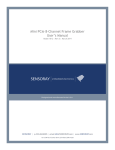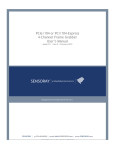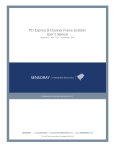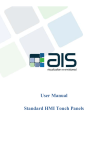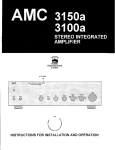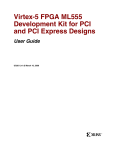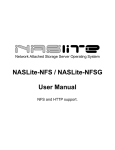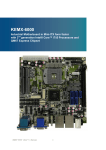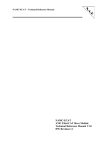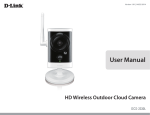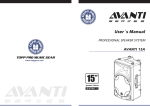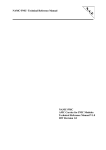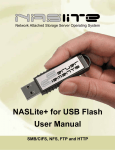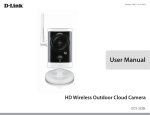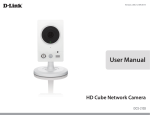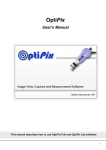Download PCI Express 4-Channel Frame Grabber User`s Manual
Transcript
PCI Express 4-Channel Frame Grabber User’s Manual Model 811 | Rev.A | December 2009 Table of Contents TABLE OF CONTENTS .................................................................................................2 LIMITED WARRANTY ..................................................................................................4 SPECIAL HANDLING INSTRUCTIONS............................................................................5 INTRODUCTION .........................................................................................................6 Feature Summary...................................................................................................7 REFERENCE ................................................................................................................8 Board Picture and Connector Layout........................................................................8 Connector List........................................................................................................9 Connector Signal/Pin Definitions............................................................................ 10 PCI-Express Bus Connector: P1 ................................................................. 10 Composite Video Input Connector, BNC: J1, J2, J3, and J4.......................... 10 Stereo Audio Input Connectors, 3.5mm TRS StereoJack: J5, J6, J7, and J8 .. 10 Full A/V (Video & Audio) and Digital I/O Connector: J9 ............................... 11 Digital I/O Connectors: TB1 ~ TB5 ............................................................ 11 DIP Switches ....................................................................................................... 11 Manufacturing DIP Switch: SW1 ................................................................ 11 Digital I/O Configuration DIP Switch: SW2 ................................................. 11 LED ..................................................................................................................... 12 Channel Status Indicators: D1 ~ D4 .......................................................... 12 GPIO Status Indicators: D5 ~ D8: ............................................................. 12 Power-OK indicators: D9, D10, D11 ........................................................... 13 SOFTWARE............................................................................................................... 14 Device Driver and SDK ......................................................................................... 14 Windows .................................................................................................... 14 Linux ......................................................................................................... 14 SPECIFICATIONS ...................................................................................................... 15 3 Limited warranty Sensoray Company, Incorporated (Sensoray) warrants the hardware to be free from defects in material and workmanship and perform to applicable published Sensoray specifications for two years from the date of shipment to purchaser. Sensoray will, at its option, repair or replace equipment that proves to be defective during the warranty period. This warranty includes parts and labor. The warranty provided herein does not cover equipment subjected to abuse, misuse, accident, alteration, neglect, or unauthorized repair or installation. Sensoray shall have the right of final determination as to the existence and cause of defect. As for items repaired or replaced under warranty, the warranty shall continue in effect for the remainder of the original warranty period, or for ninety days following date of shipment by Sensoray of the repaired or replaced part, whichever period is longer. A Return Material Authorization (RMA) number must be obtained from the factory and clearly marked on the outside of the package before any equipment will be accepted for warranty work. Sensoray will pay the shipping costs of returning to the owner parts that are covered by warranty. A restocking charge of 25% of the product purchase price will be charged for returning a product to stock. Sensoray believes that the information in this manual is accurate. The document has been carefully reviewed for technical accuracy. In the event that technical or typographical errors exist, Sensoray reserves the right to make changes to subsequent editions of this document without prior notice to holders of this edition. The reader should consult Sensoray if errors are suspected. In no event shall Sensoray be liable for any damages arising out of or related to this document or the information contained in it. EXCEPT AS SPECIFIED HEREIN, SENSORAY MAKES NO WARRANTIES, EXPRESS OR IMPLIED, AND SPECIFICALLY DISCLAIMS ANY WARRANTY OF MERCHANTABILITY OR FITNESS FOR A PARTICULAR PURPOSE. CUSTOMER’S RIGHT TO RECOVER DAMAGES CAUSED BY FAULT OR NEGLIGENCE ON THE PART OF SENSORAY SHALL BE LIMITED TO THE AMOUNT THERETOFORE PAID BY THE CUSTOMER. SENSORAY WILL NOT BE LIABLE FOR DAMAGES RESULTING FROM LOSS OF DATA, PROFITS, USE OF PRODUCTS, OR INCIDENTAL OR CONSEQUENTIAL DAMAGES, EVEN IF ADVISED OF THE POSSIBILITY THEREOF. Third party brands, names and trademarks are the property of their respective owners. 4 Special handling instructions The circuit board contains CMOS circuitry that is sensitive to Electrostatic Discharge (ESD). Special care should be taken in handling, transporting, and installing circuit board to prevent ESD damage to the board. In particular: • Do not remove the circuit board from its protective anti-static bag until you are ready to install the board into the enclosure. • Handle the circuit board only at grounded, ESD protected stations. • Remove power from the equipment before installing or removing the circuit board. 5 Introduction Model 811 is a PCI-Express version of 4-channel frame/video capture device designed for the applications requiring high capture rate from multiple input video channels. It supports capturing from NTSC/PAL/SECAM video sources. For the need of audio capturing, Model 811 provides four channels of stereo or monochrome audio capturing associated with four channels of video respectively. For each video channel, the capturing frame rate is up to 30 fps for NTSC and 25 fps for PAL. It makes total frame/video capturing rate up to 120 fps for NTSC and 100 fps for PAL. The capturing resolution can be from followings: D1.N (NTSC), D1.P (PAL), VGA, QVGA, QQVGA, SIF, 2SIF, 4SIF, CIF, QCIF, SQCIF, 4CIF. Associated with each channel, general digital I/O signals are provided, for the control and/or alarming purpose. A single +3.3V power supply through PCI-Express bus is required to power the board. Model 811 implements a single-lane (x1) PCI-Express interface. It can be plugged into a PCI Express slot of any width. 6 Feature Summary PCI-Express Video/Audio Capturing Video input: 4 individual input video channels (Composite or S-Video per channel) Audio input: 4 pair of stereo or 4 mono Resolution (Max): Full-D1: NTSC: 720 x 480 @ 30 fps x 4 PAL: 720 x 576 @ 25 fps x 4 Other supported video Resolution: D1.N: SIF: VGA: CIF: 4CIF: (Total: 120 fps) (Total: 100 fps) 720 352 640 352 704 x x x x x 480 240 480 288 576 D1.P: 2SIF: QVGA: QCIF: 720 704 320 176 x x x x 576 240 240 144 D.5: 480 x 352 4SIF: 704 x 480 QQVGA: 160 x 112 SQCIF: 128 x 96 Frame/Video capturing and encoding: Raw frame capturing: YCrCb / RGB up to 30 fps x 4, for NTSC up to 25 fps x 4, for PAL (Total: 120 fps) (Total: 100 fps) Raw video capturing: YCrCb / RGB video up to 30 fps x 4, for NTSC video up to 25 fps x 4, for PAL (Total: 120 fps) (Total: 100 fps) Raw audio capturing: audio sampling rate @ 32KHz / 48KHz JPEG frame, MPEG-1/2/4, H.264, or MJPEG A/V capturing: Can be done with 3rd party software or library, or OSS software like FFMPEG, MEncoder, and etc. 4 digital inputs and/or 4 digital outputs: TTL signals Driver and SDK for Windows available Linux drive natively supported by kernel.org, complying with V4L and/or V4l2 7 Reference Board Picture and Connector Layout 8 Connector List P1 J1 J2 J3 J4 J5 J6 J7 J8 J9 PCI-Express Connector BNC: Composite Video Input for Channel-1 BNC: Composite Video Input for Channel-2 BNC: Composite Video Input for Channel-3 BNC: Composite Video Input for Channel-4 3.5mm AudioJack: Stereo/Mono Audio Input Channel-1 3.5mm AudioJack: Stereo/Mono Audio Input Channel-2 3.5mm AudioJack: Stereo/Mono Audio Input Channel-3 3.5mm AudioJack: Stereo/Mono Audio Input Channel-4 34-pin Connector: break-in/out for for for for for Composite Video Input for Channel-1, 2, 3, and 4 S-Video Input for Channel-1, 2, 3, and 4 Stereo/mono Audio Input for Channel-1, 2, 3, & 4 Digital Inputs for Channel-1, 2, 3, and 4 Digital Output for Channel-1, 2, 3, and 4 TB1~TB4 General Purpose Digital I/O: configurable Digital Inputs for Channel-1, 2, 3, and 4 or Digital Output for Channel-1, 2, 3, and 4 9 Connector Signal/Pin Definitions PCI-Express Bus Connector: P1 Pin – Side B B1 B2 B3 B4 B5 B6 B7 B8 B9 B10 B11 ( C-Key ) B12 B13 B14 B15 B16 B17 B18 Note: * C-Key Signal +12V +12V Reserved * Ground SMCLK * SMDAT * Ground +3.3V TRST# * +3.3VAUX * WAKE# * Reserved * Ground HSOP0 HSON0 Ground PRSNT#2 Ground Pin – Side A A1 A2 A3 A4 A5 A6 A7 A8 A9 A10 A11 ( C-Key ) A12 A13 A14 A15 A16 A17 A18 Signal PRSNT#1 +12V +12V Ground TCK TDI * TDO* TMS * +3.3V +3.3V PWRGOOD Ground REFCLKP REFCLKN Ground HSIP0 HSIN0 Ground Not connected. Connector Key Composite Video Input Connector, BNC: J1, J2, J3, and J4 Pin Inner Signal Composite Video Signal Pin Outer/Ring Signal Shield, Analog ground Stereo Audio Input Connectors, 3.5mm TRS StereoJack: J5, J6, J7, and J8 Pin Tip Signal Stereo Line-in Left Pin Ring Signal Stereo Line-in Right 10 Pin Sleeve Signal Analog ground Full A/V (Video & Audio) and Digital I/O Connector: J9 Pin 1 Signal Analog Ground Pin 2 3 5 7 9 S-Video In – C for Channel-1 Audio In – R for Channel-1 Digital Output for Channel-1 Analog Ground 4 6 8 10 11 13 15 17 S-Video In – C for Channel-2 Audio In – R for Channel-2 Digital Output for Channel-2 Analog Ground 12 14 16 18 19 21 23 25 S-Video In – C for Channel-3 Audio In – R for Channel-3 Digital Output for Channel-3 Analog Ground 20 22 24 26 27 29 31 33 S-Video In – C for Channel-4 Audio In – R for Channel-4 Digital Output for Channel-4 +3.3V 28 30 32 24 Signal Composite Video In / S-Video for Channel-1 Audio In – L for Channel-1 Digital Input for Channel-1 Digital Ground Composite Video In / S-Video for Channel-2 Audio In – L for Channel-2 Digital Input for Channel-2 Digital Ground Composite Video In / S-Video for Channel-3 Audio In – L for Channel-3 Digital Input for Channel-3 Digital Ground Composite Video In / S-Video for Channel-4 Audio In – L for Channel-4 Digital Input for Channel-4 Digital Ground Not Used In – Y In – Y In – Y In – Y Digital I/O Connectors: TB1 ~ TB5 TB 1 2 3 4 5 GPIO1 – Digital GPIO2 – Digital GPIO3 – Digital GPIO4 – Digital Digital ground Signal Input/Output Input/Output Input/Output Input/Output for for for for Channel-1 Channel-2 Channel-3 Channel-4 DIP Switches Manufacturing DIP Switch: SW1 The DIP switch, SW1, is used for manufacturing only. Therefore, it is not described in this manual. Digital I/O Configuration DIP Switch: SW2 The DIP switch, SW2, is used for configuring Digital I/O routing. Refer to the table below for the routing details: 11 SW2-1 OFF X X X SW2-2 X X X X SW2-3 X OFF X ON SW2-4 X X X OFF SW2-5 X X OFF X SW2-6 X X X X X X X X ON OFF X X ON OFF ON OFF ON ON ON OFF ON OFF ON OFF ON OFF ON OFF Others Description Disconnect all digital I/O to TB1~TB4 Disconnect all digital inputs from J9 Disconnect all digital outputs to J9 Enable connectivity from J9’s digital input pins to the board (for all 4 channels) Enable connectivity from the board to J9’s digital output pins (for all 4 channels) Enable connectivity for both digital inputs & outputs from/to J9 connector Enable connectivity for both digital inputs & outputs from/to J9 connector; And, route the digital inputs connected to the TB1 ~ TB4 Enable connectivity for both digital inputs & outputs from/to J9 connector; And, route the digital outputs connected to the TB1 ~ TB4 Reserved LED Channel Status Indicators: D1 ~ D4 The LED D1, D2, D3, and D4 can be used for indicating the channel status, respectively. LED D1 D2 D3 D4 Signal Status for Channel-1, the driving signal is connected to the Channel-1 capturing chipset SAA713xHL’s GPIO15. A logic low turns the LED on, and a high turns it off Status for Channel-2, the driving signal is connected to the Channel-2 capturing chipset SAA713xHL’s GPIO15. A logic low turns the LED on, and a high turns it off Status for Channel-3, the driving signal is connected to the Channel-3 capturing chipset SAA713xHL’s GPIO15. A logic low turns the LED on, and a high turns it off Status for Channel-4, the driving signal is connected to the Channel-4 capturing chipset SAA713xHL’s GPIO15. A logic low turns the LED on, and a high turns it off GPIO Status Indicators: D5 ~ D8: The LED D5, D6, D7, & D8 are used for indicating the status of the digital input/output signals (pins), labeled as GPIO1 ~ GPIO4 on the board, and directly connected to the TB1 ~ TB4. A logic 0 (low) turns the LED on and a logic 1 (high) turns it off. 12 LED D5 D6 D7 D8 Status Status Status Status of of of of GPIO1 GPIO2 GPIO3 GPIO4 Signal (associated (associated (associated (associated with with with with Channel-1) Channel-2) Channel-3) Channel-4) Power-OK indicators: D9, D10, D11 The LED D9, D10, and D11 are used for indicating on-board Power-OK status. LED D9 D10 D11 Signal 1.5V Power-OK Status 3.3V Power-OK Status Power-OK Status for PCI-Express to PCI bridge, PLX PEX8112 13 Software Device Driver and SDK Device driver and SDK including driver API & demo application programs are available for both Windows and Linux. Windows Sensoray Co. provides 811 WDM driver and DirectX filter for Windows platform. The SDK includes the Windows driver, DLL, Demo application & source code, etc. It is packaged in a “s811_v1xx.zip” file for distribution and/or for customer(s) to download from Sensoray’s website. Refer to the “Model 811 Windows SDK User’s Manual” for the SDK, DLL, API, and programming details. Since the driver is built and based on the WDM BDA and DirectShow oriented architecture, the Microsoft GraphEdit utility can be used for building live A/V preview and/or capturing application. Also, 3rd party freeware/shareware like VLC player and AMCap software can be used for still/live video capturing and preview. Linux The device driver for Linux is natively in the Linux kernel, provided by kernel.org and comes with most commonly used and/or popular Linux distributions. The API complies with standard V4L2 (Video for Linux Version 2), formerly known as V4L (Video for Linux). The API spec and capturing sample program can be downloaded from following websites: http://v4l2spec.bytesex.org/ http://www.linuxtv.org/downloads/video4linux/API/V4L2_API/spec-single/v4l2.html In addition to the application samples from V4L/V4L2, Sensoray Co. provides customized capturing sample/demo programs and HOW-TO type of app/instruction notes for the Model 811, upon customer’s requests. For live video preview or capturing, commonly used V4L application programs like XawTV can be used for capturing/previewing from each channel of the 811. For capturing JPEG frame, MPEG-1/2/4, H.264 or MJPEG video, 3rd party’s or OSS libraries and CODECs can be used and integrated in the application programs. As a good example, FFMPEG (http://en.wikipedia.org/wiki/FFmpeg) is a well-known and highly recommended OSS that can be used with 811. Sensoray Co. provides an application note on how to use command-line based FFMPEG to capture compressed A/V (video or audio). 14 Specifications Video Formats Video Inputs Audio Inputs Capturing Mode Capture rate Frame/Video Encoding Resolution Digital I/O Bus OS Platform Power Temperature Board Size NTSC, PAL, SECAM 4 input channels, simultaneously: 4 Composite video via 4 NBC connectors, 75 Ohms; or 4 S-Video via a 34-pin breakout connector, 75 Ohms; or combinations up to 4 channels , 75 Ohms 4 input channels: associated with 4 separated video channels Stereo or mono for each channel, via four 3.5mm TRS StereoJacsk; Or, break-in stereo/mono signal from a 34-pin connector Signal level: Line-in level, +/- 1.0V Raw: RGB or YUV Up to: 120 (30x4) frames/sec for NTSC/RS-170/CCIR 100 (25x4) frames/sec for PAL/SECAM Could be done by software and/or 3rd party CODEC: JPEG, MPEG-1/2/4, MJPEG, and H.264 Up to Full-D1: NTSC: 720x480 PAL: 720x576 Supported: D1.N: 720x480 D1.P: 720x576 D.5: 480x352 SIF: 352x240 2SIF: 704x240 4SIF: 704x480 VGA: 640x480 QVGA: 320x240 QQVGA: 160x112 CIF: 352x288 QCIF: 176x144 SQCIF: 128x96 4CIF: 704x576 4 inputs + 4 outputs: TTL signals 4 configurable inputs/outputs, via I/O terminals; all 4 inputs + all 4 outputs on breakout 34-pin connector PCI-Express x1: Compliant of PCI-Express Base Specification (Revision 1.0/1.1) PCI-to-PCI Bridge Specification (Revision1.2) Windows and Linux 6.6W, +3.3V @ 2A 0 – 70 C 4.2” x 4.2” (107mm x 107mm) 15















